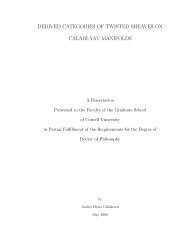A Course on Large Deviations with an Introduction to Gibbs Measures.
A Course on Large Deviations with an Introduction to Gibbs Measures.
A Course on Large Deviations with an Introduction to Gibbs Measures.
Create successful ePaper yourself
Turn your PDF publications into a flip-book with our unique Google optimized e-Paper software.
6 1. Introducti<strong>on</strong><br />
sequence <strong>with</strong> [hn] zeros <strong>an</strong>d <strong>on</strong>es, then we have 2 [hn] possible words <strong>to</strong> use.<br />
One should then have<br />
<br />
n<br />
≤ 2<br />
[ns]<br />
[hn] .<br />
Using Stirling’s formula (or directly applying (1.1)) <strong>on</strong>e obtains that the<br />
minimal possible h is<br />
<strong>with</strong> I 1/2 given in (1.1).<br />
h(s) = −s log 2 s − (1 − s) log 2(1 − s) = 1 − I 1/2(s)<br />
log 2 ,<br />
Note that h(0) = h(1) = 0. This makes sense, since if we know s = 0<br />
(respectively, s = 1) then we know we will <strong>on</strong>ly get zeros (respectively, <strong>on</strong>es).<br />
Thus, there is nothing <strong>to</strong> encode. This is the case of complete order. On the<br />
other h<strong>an</strong>d, h(1/2) = 1. This <strong>to</strong>o makes sense since there is no informati<strong>on</strong><br />
<strong>on</strong>e c<strong>an</strong> extract from a sequence of fair coin <strong>to</strong>sses <strong>an</strong>d <strong>on</strong>e needs all n<br />
bits <strong>to</strong> encode the sequence. This is the case of complete disorder. For<br />
s ∈ (0, 1/2), <strong>on</strong>e knows that a 1 is less likely <strong>to</strong> occur th<strong>an</strong> a 0 <strong>an</strong>d hence<br />
<strong>on</strong>e should be able <strong>to</strong> c<strong>on</strong>serve <strong>an</strong>d use fewer th<strong>an</strong> n bits <strong>to</strong> encode the<br />
sequence. However, the above formula says that <strong>on</strong>e c<strong>an</strong>not do better th<strong>an</strong><br />
h(s)n. This, of course, does not tell us what the best encoding algorithm is.<br />
1.2. Thermodynamic entropy<br />
Once again, for the sake of illustrati<strong>on</strong>, we will describe <strong>an</strong> oversimplified<br />
system. This secti<strong>on</strong> is inspired by Schrödinger’s course [34].<br />
C<strong>on</strong>sider a physical system of n independent identical comp<strong>on</strong>ents. By<br />
independent we me<strong>an</strong> that the comp<strong>on</strong>ents do not communicate <strong>with</strong> each<br />
other. By identical we me<strong>an</strong> that each of them has the same “mech<strong>an</strong>ism”<br />
attached <strong>to</strong> it, screws, pist<strong>on</strong>s, <strong>an</strong>d what not. Each comp<strong>on</strong>ent c<strong>an</strong> be at <strong>an</strong><br />
energy level from the set {εℓ : ℓ ∈ N}. We submit the system <strong>to</strong> a heat bath<br />
at a fixed absolute temperature T which causes it <strong>to</strong> have <strong>to</strong>tal energy E. Let<br />
aℓ be the number of comp<strong>on</strong>ents in state εℓ. The system tries <strong>to</strong> maximize<br />
its disorder by choosing aℓ’s so that the number of possible c<strong>on</strong>figurati<strong>on</strong>s<br />
n!<br />
a1!···aℓ!··· is as large as possible, subject <strong>to</strong> the c<strong>on</strong>straints aℓ = n <strong>an</strong>d<br />
<br />
aℓεℓ = E.<br />
Equivalently, <strong>on</strong>e c<strong>an</strong> maximize the logarithm of the qu<strong>an</strong>tity in questi<strong>on</strong><br />
<strong>an</strong>d use Lagr<strong>an</strong>ge multipliers <strong>to</strong> achieve this optimizati<strong>on</strong> task; see page 266<br />
of Bartle’s textbook [3]. First, <strong>on</strong>e sets the gradient of<br />
log<br />
n!<br />
a1! · · · aℓ! · · · − α aℓ − β aℓεℓ
















